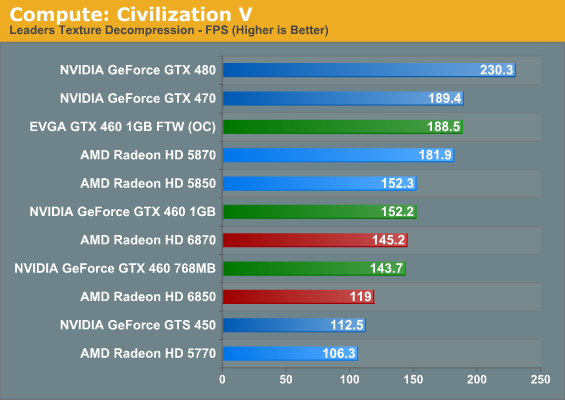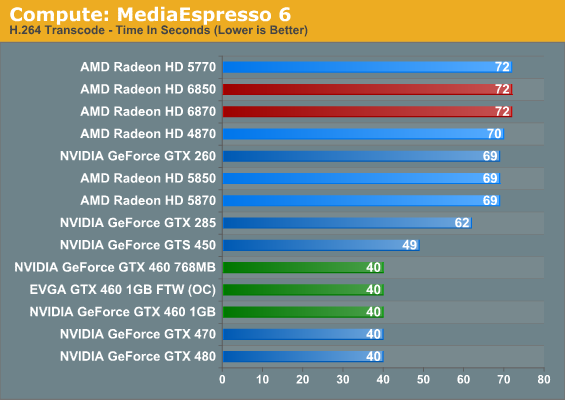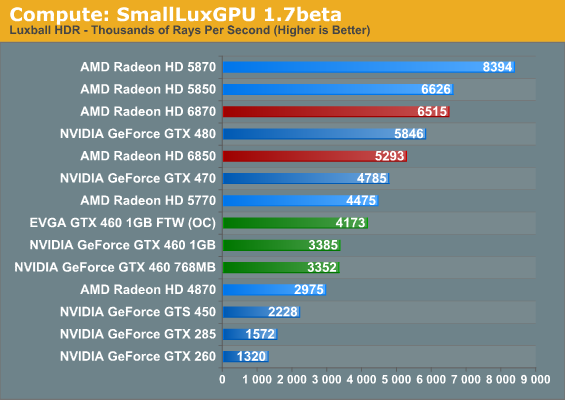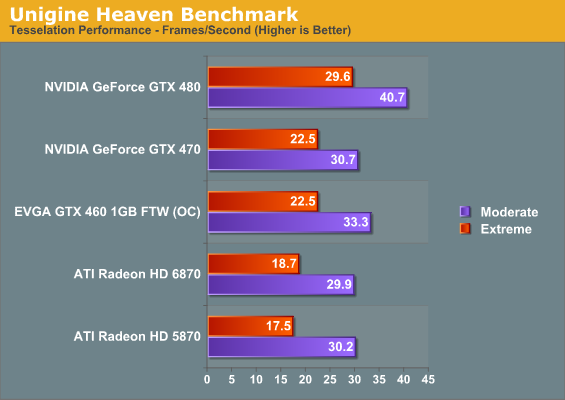AMD’s Radeon HD 6870 & 6850: Renewing Competition in the Mid-Range Market
by Ryan Smith on October 21, 2010 10:08 PM ESTFor a while now we’ve been trying to establish a proper cross-platform compute benchmark suite to add to our GPU articles. It’s not been entirely successful.
While GPUs have been compute capable in some form since 2006 with the launch of G80, and AMD significantly improved their compute capabilities in 2009 with Cypress, the software has been slow to catch on. From gatherings such as NVIDIA’s GTC we’ve seen first-hand how GPU computing is being used in the high-performance computing market, but the consumer side hasn’t materialized as quickly as the right situations for using GPU computing aren’t as straightforward and many developers are unwilling to attach themselves to a single platform in the process.
2009 saw the ratification of OpenCL 1.0 and the launch of DirectCompute, and while the launch of these cross-platform APIs removed some of the roadblocks, we heard as recently as last month from Adobe and others that there’s still work to be done before companies can confidently deploy GPU compute accelerated software. The immaturity of OpenCL drivers was cited as one cause, however there’s also the fact that a lot of computers simply don’t have a suitable compute-capable GPU – it’s Intel that’s the world’s biggest GPU vendor after all.
So here in the fall of 2010 our search for a wide variety of GPU compute applications hasn’t panned out quite like we expected it too. Widespread adoption of GPU computing in consumer applications is still around the corner, so for the time being we have to get creative.
With that in mind we’ve gone ahead and cooked up a new GPU compute benchmark suite based on the software available to us. On the consumer side we have the latest version of Cyberlink’s MediaEspresso video encoding suite and an interesting sub-benchmark from Civilization V. On the professional side we have SmallLuxGPU, an OpenCL based ray tracer. We don’t expect this to be the be all and end all of GPU computing benchmarks, but it gives us a place to start and allows us to cover both cross-platform APIs and NVIDIA & AMD’s platform-specific APIs.
Our first compute benchmark comes from Civilization V, which uses DirectCompute to decompress textures on the fly. Civ V includes a sub-benchmark that exclusively tests the speed of their texture decompression algorithm by repeatedly decompressing the textures required for one of the game’s leader scenes.

In our look at Civ V’s performance as a game, we noted that it favors NVIDIA’s GPUs at the moment, and this may be part of the reason why. NVIDIA’s GPUs clean up here, particularly when compared to the 6800 series and its reduced shader count. Furthermore within the GPU families the results are very straightforward, with the order following the relative compute power of each GPU. To be fair to AMD they made a conscious decision to not chase GPU computing performance with the 6800 series, but as a result it fares poorly here.
Our second compute benchmark is Cyberlink’s MediaEspresso 6, the latest version of their GPU-accelerated video encoding suite. MediaEspresso 6 doesn’t currently utilize a common API, and instead has codepaths for both AMD’s APP (née Stream) and NVIDIA’s CUDA APIs, which gives us a chance to test each API with a common program bridging them. As we’ll see this doesn’t necessarily mean that MediaEspresso behaves similarly on both AMD and NVIDIA GPUs, but for MediaEspresso users it is what it is.

We decided to go ahead and use MediaEspresso in this article not knowing what we’d find, and it turns out the results were both more and less than we were expecting at the same time. While our charts don’t show it, video transcoding isn’t all that GPU intensive with MediaEspresso; once we achieve a certain threshold of compute performance on a GPU – such as a GTX 460 in the case of an NVIDIA card – the rest of the process is CPU bottlenecked. As a result all of our Fermi NVIDIA cards at the GTX 460 or better take just as long to encode our sample video, and while the AMD cards show some stratification, it’s on the order of only a couple of seconds. From this it’s clear that with Cyberlink’s technology having a GPU is going to help, but it can’t completely offload what’s historically been a CPU-intensive activity.
As for an AMD/NVIDIA cross comparison, the results are straightforward but not particularly enlightening. It turns out that MediaEspresso 6 is significantly faster on NVIDIA GPUs than it is on AMD GPUs, but since we’ve already established that MediaEspresso 6 is CPU limited when using these powerful GPUs, it doesn’t say anything about the hardware. AMD and NVIDIA both provide common GPU video encoding frameworks for their products that Cyberlink taps in to, and it’s here where we believe the difference lies.
In particular we see MediaEspresso 6 achieve 50% CPU utilization (4 core) when being used with an NVIDIA GPU, while it only achieves 13% CPU utilization (1 core) with an AMD GPU. At this point it would appear that the CPU portions of NVIDIA’s GPU encoding framework are multithreaded while AMD’s framework is singlethreaded. And since the performance bottleneck for video encoding still lies with the CPU, this would be why the NVIDIA GPUs do so much better than the AMD GPUs in this benchmark.
Our final GPU compute benchmark is SmallLuxGPU, the GPU ray tracing branch of the open source LuxRender renderer. While it’s still in beta, SmallLuxGPU recently hit a milestone by implementing a complete ray tracing engine in OpenCL, allowing them to fully offload the process to the GPU. It’s this ray tracing engine we’re testing.

Compared to our other two GPU computing benchmarks, SmallLuxGPU follows the theoretical performance of our GPUs much more closely. As a result our Radeon GPUs with their difficult-to-utilize VLIW5 design end up topping the charts by a significant margin, while the fastest comparable NVIDIA GPU is still 10% slower than the 6850. Ultimately what we’re looking at is what amounts to the best-case scenarios for these GPUs, with this being as good an example as any that in the right circumstances AMD’s VLIW5 shader design can go toe-to-toe with NVIDIA’s compute-focused design and still win.
At the other end of the spectrum from GPU computing performance is GPU tessellation performance, used exclusively for graphical purposes. For the Radeon 6800 series, AMD enhanced their tessellation unit to offer better tessellation performance at lower tessellation factors. In order to analyze the performance of AMD’s enhanced tessellator, we’re using the Unigine Heaven benchmark and Microsoft’s DirectX 11 Detail Tessellation sample program to measure the tessellation performance of a few of our cards.

Since Heaven is a synthetic benchmark at the moment (the DX11 engine isn’t currently used in any games) we’re less concerned with performance relative to NVIDIA’s cards and more concerned with performance relative to the 5870. Compared to the 5870 the 6870 ends up being slightly slower when using moderate amounts of tessellation, while it pulls ahead when using extreme amounts of tessellation. Considering that the 6870 is around 7% slower in games than the 5870 this is actually quite an accomplishment for Barts, and one that we can easily trace back to AMD’s tessellator improvements.

Our second tessellation test is Microsoft’s DirectX 11 Detail Tessellation sample program, which is a much more straightforward test of tessellation performance. Here we’re simply looking at the framerate of the program at different tessellation levels, specifically level 7 (the default level) and level 11 (the maximum level). Here AMD’s tessellation improvements become even more apparent, with the 6870 handily beating the 5870. In fact our results are very close to AMD’s own internal results – at level 7 the 6870 is 43% faster than the 5870, while at level 11 that improvement drops to 29% as the increased level leads to an increasingly large tessellation factor. However this also highlights the fact that AMD’s tessellation performance still collapses at high factors compared to NVIDIA’s GPUs, making it all the more important for AMD to encourage developers to use more reasonable tessellation factors.










197 Comments
View All Comments
Super_Herb - Sunday, October 24, 2010 - link
I love it - "as a matter of policy we do not include overclocked cards on general reviews"..........but this time nVidia said pretty please so we did. But because our strict ethical policy doesn't allow us to include them we'll just tell you we did it this one special time because a manufacturer specifically sent us a special card and then our integrity is still 100% intact......right? Besides, the "special" card nVidia sent us was so shiny and pretty!Back to [H]ard to get the real story.
Super_Herb - Sunday, October 24, 2010 - link
I love it - "as a matter of policy we do not include overclocked cards on general reviews"..........but this time nVidia said pretty please so we did. But because our strict ethical policy doesn't allow us to include them we'll just tell you we did it this one special time because a manufacturer specifically sent us a special card and then our integrity is still 100% intact......right? Besides, the "special" card nVidia sent us was so shiny and pretty!Back to [H]ard to get the real story.
Super_Herb - Sunday, October 24, 2010 - link
I love it - "as a matter of policy we do not include overclocked cards on general reviews"..........but this time nVidia said pretty please so we did. But because our strict ethical policy doesn't allow us to include them we'll just tell you we did it this one special time because a manufacturer specifically sent us a special card and then our integrity is still 100% intact......right? Besides, the "special" card nVidia sent us was so shiny and pretty!Back to [H]ard to get the real story.
Super_Herb - Sunday, October 24, 2010 - link
"As a matter of policy we do not include overclocked cards on general reviews"..........but this time nVidia said pretty please so we did. But because our strict ethical policy doesn't allow us to include them we'll just tell you we did it this one special time because a manufacturer specifically sent us a special card and then our integrity is still 100% intact......right? Besides, the "special" card nVidia sent us was so shiny and pretty!Back to [H]ard to get the real story.
Will Robinson - Sunday, October 24, 2010 - link
Its amazing how many sites have used the FTW overclocked card as their NVDA comparison card.Think its a fluke?....even websites in Sweden were sent one with directions from NVDA to use it.....too bad the FTW card isn't even available in that country.....
mcnels1 - Sunday, October 24, 2010 - link
On the power use page, the article states :Because we use a 1200W PSU in our GPU test rig our PSU efficiency at idle is quite low, leading to the suppression of the actual difference between cards.
Actually, an inefficient power supply has the opposite effect, increasing the apparent difference. If the power supply were 100% efficient, then each additional watt used by the graphics card would show up as one additional measured watt used. But if the power supply is only 50% efficient, each additional watt used by the graphics card is measured as two additional watts.
JEEPMON - Sunday, October 24, 2010 - link
Please lose the 'Mexican Standoff' Just use standoff, much more professional and politically correct.Wolfpup - Monday, October 25, 2010 - link
Regarding texture filtering/mip map levels-is it possible this deficiency has existed since at least 2005 in AMD parts? I notice that in a LOT of Xbox 360 games.Sabresiberian - Monday, October 25, 2010 - link
I'm a gamer, video is a far second for me, but AMD just put the crown firmly on their head and if that's what I was after I'd be thrilled with these cards at these prices.;)
DarkUltra - Wednesday, October 27, 2010 - link
Have you checked in-game texture quality during motion? My GeForce GTX 285 have shimmering textures at max texture quality and 16xAF which are very noticeable when walking around in a game. As the GTX 285 have same type of AF quality, is this shimmering also present on the 480 or the 6870?http://www.youtube.com/watch?v=JVjM_vrsBO8